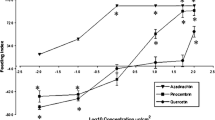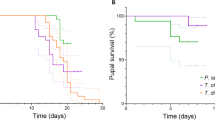Abstract
Larvae of the lycaenid butterflyPolyommatus icarus were reared on inflorescences ofCoronilla varia andMedicago sativa, which are rich in flavonoids. Twelve different flavonoids (five compounds from the former and nine from the latter), including aglycones andO-glycosides of kaempferol, quercetin, and myricetin were isolated and identified by spectroscopic means. NMR and MS data for the new acylated glycoside kaempferol 3-O-6″-(3-hydroxy-3-methylglutaroyl)-β-d-glucopyranoside are reported. Comparative HPLC analysis of the respective host plants and of larvae, pupae, and imagines ofP. icarus indicated selective uptake and accumulation of kaempferol vs. quercetin and myricetin derivatives. The latter were excreted largely unchanged through the feces. Irrespective of the larval host plant kaempferol 3-O-glucoside was found as the major flavonoid in larvae, pupae, and imagines ofP. icarus, accounting for approximately 83–92% of all soluble flavonoids in adult butterflies. Within the imagines, approximately 80% of all flavonoids are stored in the wings (especially in the orange submarginal lunules), whereas the remaining 20% reside in the bodies. Feeding experiments with artificial diet demonstrated that the insects are able to form kaempferol 3-O-glucoside by glucosylation of dietary kaempferol. Possible functions of the sequestered flavonoids, especially for mate recognition ofP. icarus, are discussed.
Similar content being viewed by others
References
Ahmad, S.A., Brattsten, L.B., Mullin, C.A., andYu, S.J. 1986. Enzymes involved in the metabolism of plant allelochemicals, pp. 73–152,in L.B. Brattsten and S.A. Ahmad (eds.). Molecular Aspects of Insect-Plant Associations. Plenum Press, New York.
Bernard, G.D., andRemington, C.L. 1991. Color vision inLycaena butterflies: Spectral tuning of receptor arrays in relation to behavioral ecology.Proc. Natl. Acad. Sci. U.S.A. 88:2783–2787.
Douwes, P. 1976. Mating behavior inHeodes virgaurea with particular reference to the stimuli from the female (Lepidoptera: Lycaenidae).Entomol. Ger. 2:232–241.
Fiedler, K. 1991. Systematic, evolutionary, and ecological implications of myrmecophily within the Lycaenidae (Insecta: Lepidoptera: Papilionidae).Bonner Zool. Monogr. 31:1–210.
Ford, E.B. 1941. Studies on the chemistry of pigments in the Lepidoptera with reference to their bearing on systematics. 1. The anthoxanthins.Proc. R. Entomol. Soc. London Ser. A. 16:65–90.
Hamamura, Y., Hayashiya, K., Naito, K., Matsuura, K., andNishida, J. 1962. Food selection by silkworm larvae.Nature 194:754–755.
Harborne, J.B. 1991. Flavonoid pigments, pp. 389–429,in G.A. Rosenthal and M.R. Berenbaum (eds.). Herbivores: Their Interaction with Secondary Plant Metabolites. 2nd. ed., Vol. 1. Academic Press, San Diego.
Hopkins, T.L., andAhmad, S.A. 1991. Flavonoid wing pigments in grasshoppers.Experientia 47:1089–1091.
Meyer-Rochow, V.B. 1991. Differences in ultraviolet wing patterns in the New Zealand lycaenid butterfliesLycaena salustius, L. rauparaha, andL. feredayi as a likely isolating mechanism.J.R. Soc. N.Z. 21:169–177.
Morris, S.H., andThomson, R.H. 1963. The flavonoid pigments of the marbled white butterfly (Melanargia galathea Seltz).J. Insect Physiol. 9:391–399.
Rhoades, D.F. 1977. Integrated antiherbivore, antidessicant and ultraviolet screening properties of Creosote bush resin.Biochem. Syst. Ecol. 5:281–290.
Silberglied, R.E. 1979. Communication in the ultraviolet.Annu. Rev. Ecol. Syst. 10:373–398.
Silberglied, R.E. 1984. Visual communication and sexual selection among butterflies, pp. 207–223,in R.I. Vane-Wright and P.R. Ackery (eds.). The Biology of Butterflies. Academic Press, San Diego.
Wald, B., Galensa, R., Herrmann, K., Grotjahn, L., andWray, V. 1986. Quercetin 3-O-(6″-(3-hydroxy-3-methylglutaryl)-β-galactoside from blackberries.Phytochemistry 25:2904–2905.
Wilson, A. 1985. Flavonoid pigments of butterflies in the genusMelanargia.Phytochemistry 24:1685–1691.
Wilson, A. 1986. Flavonoid pigments in swallowtail butterflies.Phytochemistry 25:1309–1313.
Wilson, A. 1987. Flavonoid pigments in chalkhill blue (Lysandra coridon Poda) and other lycaenid butterflies.J. Chem. Ecol. 13:473–493.
Author information
Authors and Affiliations
Rights and permissions
About this article
Cite this article
Wiesen, B., Krug, E., Fiedler, K. et al. Sequestration of host-plant-derived flavonoids by lycaenid butterflyPolyommatus icarus . J Chem Ecol 20, 2523–2538 (1994). https://doi.org/10.1007/BF02036189
Received:
Accepted:
Issue Date:
DOI: https://doi.org/10.1007/BF02036189




